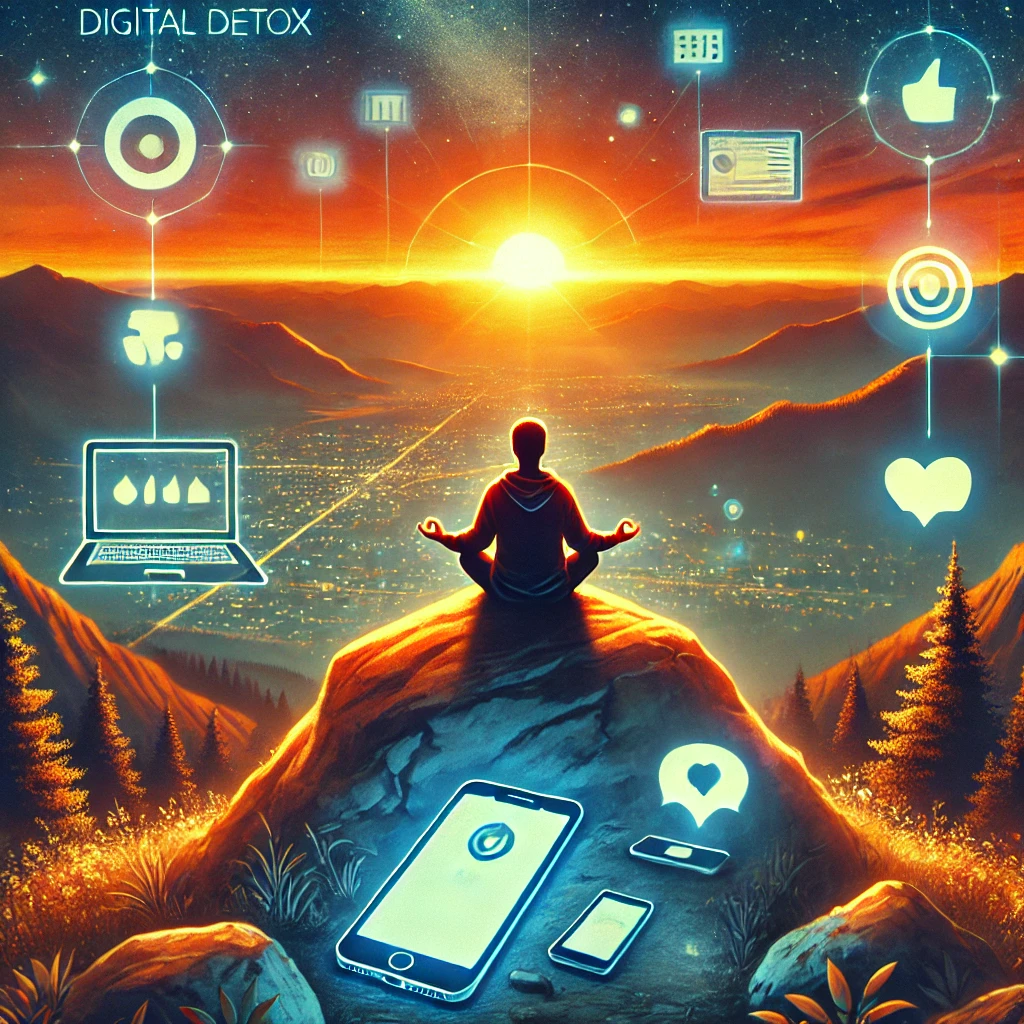Digital detox can be defined as a deliberate period of abstaining from digital devices, such as smartphones, computers, tablets, and social media platforms, to mitigate the negative effects of excessive screen time. Emerging as a response to the pervasive use of technology, it addresses growing concerns about screen addiction’s impact on mental and physical well-being. Approaches to digital detox vary, ranging from setting specific limits on device usage to complete abstinence, sometimes facilitated by dedicated retreats or travel packages. In today’s hyper-connected world, where constant online presence has become the norm, digital detox offers a counterbalance, encouraging individuals to re-engage with offline activities and practice mindfulness.
The concept has gained significant traction as research increasingly highlights the adverse effects of prolonged digital engagement. For example, a study found that 25% of smartphone owners aged 18-44 cannot recall the last time their phone wasn’t within arm’s reach, underscoring the depth of digital dependency in modern life (Digital Detox: What to Know – WebMD). This context positions digital detox as a critical strategy for reclaiming personal well-being in an era dominated by incessant connectivity.
Benefits of Digital Detox
The benefits of digital detox are well-supported by research and offer substantial improvements across mental, physical, and social domains:
- Reduced Stress and Anxiety: The barrage of notifications and the pressure to remain connected can significantly elevate stress levels. A 2017 report from the American Psychological Association revealed that 42% of Americans experience heightened stress due to political and cultural discussions on social media (Stress in America: Coping with Change – APA). By unplugging, individuals allow their minds to unwind, with social experiments demonstrating reduced stress levels following scheduled breaks from digital devices (Digital Detox: What to Know – WebMD).
- Improved Focus and Productivity: Digital distractions, such as notifications and social media scrolling, fragment attention and hinder productivity. Research from the University of California, Irvine, showed that workers who took regular breaks from email experienced lower stress and higher productivity. A digital detox fosters an environment conducive to deep thought and sustained focus, enabling more effective task completion.
- Better Mental Health: Excessive social media use has been linked to increased depression and anxiety. A study published in the Journal of Social and Clinical Psychology found that limiting social media to 30 minutes per day for two weeks resulted in significant improvements in mental health, reducing symptoms of depression and anxiety (The Facebook Experiment – Liebertpub). This suggests that unplugging can cultivate a healthier mental state.
- Enhanced Real-Life Social Interactions: Digital devices often detract from face-to-face interactions, weakening social bonds. A Common Sense Media survey indicated that 60% of teens feel excessive screen time interferes with meaningful conversations with friends and family (The Common Sense Census- Common Sense Media). By prioritizing offline engagement, digital detox strengthens relationships and fosters deeper, more authentic connections.
- Less Comparison and FOMO: Social media platforms frequently trigger harmful comparisons and the Fear of Missing Out (FOMO), both of which erode well-being. A University of Pennsylvania study linked higher social media use to increased FOMO and decreased life satisfaction (No More FOMO – Guilford Journals). Reducing exposure through a detox can improve self-esteem and alleviate the pressure of constant comparison.
- Better Sleep: Screen time before bed disrupts sleep patterns, largely due to blue light exposure. Studies confirm that unplugging leads to longer, more restful sleep—an essential factor for overall health and daily functioning (Sleep Hygiene – Sleep Foundation).
- Increased Physical Activity: By freeing up time typically spent on digital media, individuals can engage in physical activities, yielding positive health outcomes.
Challenges of Digital Detox
While the benefits of digital detox are compelling, several challenges can impede its adoption and effectiveness, reflecting the complexities of disconnecting in a hyper-connected society:
- Feeling Isolated: Disconnecting from digital networks can lead to feelings of isolation. Studies show that participants often report a sense of alienation when friends and family remain online, making social disconnection a notable barrier.
- Difficulty Managing Work or Communications: Many professional environments demand constant availability, with 43% of workers feeling pressure to be accessible 24/7 due to work-related communications (2018 Global Human Capital Trends – Deloitte). This expectation complicates efforts to unplug, as missing critical updates can impact job performance and career progression.
- Withdrawal Symptoms: For heavy digital users, unplugging can trigger withdrawal symptoms akin to those seen in substance abuse, such as anxiety or restlessness. Research from the University of Derby found that frequent smartphone users exhibit addiction-like behaviors when separated from their devices, adding a layer of difficulty to the detox process (Out of sight is not out of mind- ScienceDirect).
- Fear of Missing Out (FOMO): The anxiety of missing important news, events, or social interactions poses a significant hurdle. A study in Cyberpsychology, Behavior, and Social Networking linked FOMO to higher social media use and lower well-being, suggesting that this fear can deter individuals from fully committing to a detox (FOMO in Cyberspaces – Liebertpub).
- Social Pressure: Expectations from peers or family to stay connected can undermine detox efforts. Online surveys found that a good percentage of teens feel pressure to share their location or respond immediately to messages, amplifying the challenge of maintaining a disconnection period.
- Dependency on Digital Tools: Daily tasks such as banking, shopping, or navigation often rely on digital devices, rendering complete disconnection impractical. This dependency is especially pronounced in urban settings, where digital services are deeply integrated into everyday life.
- Boredom: Without digital entertainment, individuals may struggle with boredom, particularly if they lack alternative leisure activities. Many people prefer almost any activity over sitting alone with their thoughts, highlighting the discomfort some experience during a detox
Variability by Demographics and Context
An intriguing aspect of digital detox is how its experience varies across demographics and contexts. Younger individuals, especially teens and young adults, may find it more challenging to disconnect due to their reliance on social media for social interaction and identity formation. For example, the Common Sense Media survey noted that 60% of teens feel screens hinder meaningful conversations, suggesting a steeper adjustment curve for this group (The Common Sense Census – Common Sense Media).
Occupation also influences the feasibility of detox. Professionals in high-demand roles—such as customer service, emergency response, or digital marketing—face greater obstacles due to work-related connectivity expectations, with 43% reporting pressure to be available around the clock, according to a Deloitte survey (2018 Global Human Capital Trends). Conversely, those in less connected occupations, like artists or manual laborers, might find it easier to unplug, though they may still encounter social pressure from personal networks. These variations underscore the need for tailored approaches to digital detox.
Strategies to Overcome Challenges
To navigate these challenges, one can employ practical strategies:
- Informing friends and family about the detox period to reduce social pressure and set expectations.
- Setting up an out-of-office message for work emails to manage professional obligations.
- Planning alternative activities, such as reading, exercising, or pursuing hobbies, to combat boredom.
- Opting for partial detoxes—limiting specific apps or establishing device-free hours—to balance connectivity needs with the benefits of unplugging.
These measures can make digital detox more manageable and sustainable, addressing both logistical and psychological barriers.
Digital detox presents a powerful opportunity to counter the effects of our hyper-connected world, offering benefits like reduced stress, improved mental health, and stronger real-life connections. However, challenges such as isolation, work demands, and digital dependency highlight the need for thoughtful implementation. By understanding these dynamics and customizing strategies to individual circumstances, digital detox can become an effective tool for achieving a healthier balance between online and offline life. As technology continues to evolve, the ability to unplug intentionally remains a vital skill for well-being in the digital age.


